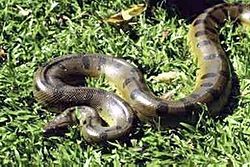Green anaconda
| Green Anaconda | |
|---|---|

| |
| Scientific classification | |
| Kingdom: | |
| Phylum: | |
| Genus: | |
| Species: | E. murinus
|
| Binomial name | |
| Eunectes murinus (Linnaeus, 1758)
| |
| Synonyms | |
|
Boa murina | |
The Green Anaconda (Eunectes murinus) is a giant South American snake. It is the largest member of the boa family and the most heavy bodied member of the Order Squamata.
It is among the largest snakes in the world, reaching lengths up to 9.5m[1], though average size is closer to 9 meters (26 feet)[2]. It rivals the Reticulated Python for length, but is typically considerably heavier. It can weigh 250 kg (550 lb) and have a girth of more than 30 cm (11.8 inches) in diameter[1]. The Green Anaconda might be the most exaggerated animal on earth in terms of size, with reports of lengths ranging up to 40 m (131 feet). Probably the largest snake ever actually measured was a shot-but-not-killed female near the Colombia-Venezuela border in 1944. This unweighed giant was measured as being 9.5m, before it apparently slithered off from its hunter, who thought it died.[2] Females are significantly larger than males, having the largest sexual dimorphism of all the snakes. Cryptozoologists believe that the green anaconda species is responsible for the sightings of giant anacondas.
Their primary overall color is an olive green, with black blotches that run the length of the body. Their head is narrow compared to the rest of the body, with most exhibiting distinctive orange-yellow striping on either side. Their eyes are set high on their head so as to allow the snake to be able to see out of the water without exposing the rest of its body.
Geographic range
Green Anaconda's are found mainly in northern South America on the Amazon River.
Behavior

Exhibit in the Senckenberg Museum

Green anacondas, like all anacondas, are primarily aquatic. They eat a wide variety of prey, almost anything they can manage to overpower, including: fish, birds, a variety of mammals, and other reptiles. Particularly large anacondas may even consume large prey such as tapir, deer, capybara, caiman, and sometimes crocodiles and jaguars, but such large meals are not regularly consumed. In addition, there have been many reports and documentaries on anacondas consuming humans.They employ constriction to subdue their prey. Cannibalism among green anacondas is also known, most recorded cases involving a larger female consuming a smaller male. Scientists cite several possible reasons for this, including the dramatic sexual dimorphism in the species and the possibility that female anacondas require additional food intake after breeding to sustain their long gestation period and the male simply being an opportunistic prey item, but the exact reason is not understood.[3] In captivity, anacondas are known for their aggressive disposition.[4]
Reproduction
Anacondas are solitary animals until mating. During the mating season (corresponding to the rainy season) males must find the females, and while it is still unclear how they track a female's scent, many males often go after the same female. This in turn results in odd clusters colloquially called "breeding balls" in which up to 12 males wrap around the same female attempting to copulate. Copulation takes place in the water, with gestation lasting approximately 6 months. Anacondas are ovoviviparous, meaning that they produce eggs which hatch inside the mother's body and result in live births. The newborn, which usually number 20-30, are around 60 centimetres in size and receive no parental care. Should they survive, they reach sexual maturity in about 3 to 4 years.
References
<references / [[cs:Anakond
- ^ [3]
- ^ The Guinness Book of Animal Facts and Feats - Wood, G.; Sterling Pub Co Inc, New York. 978-0851122359 (1983)
- ^ Eunectes murinus (Green Anaconda): Cannibalism
- ^ LLLReptile: Green Anaconda Captive Care
